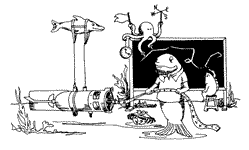
|
The IEEE Seventh Working Conference on Current Measurement TechnologyCurrent and Wave Monitoring and Emerging TechnologiesMarch 13-15 | Bahia Hotel | San Diego, CA, USA |
||
|
Technical Program Accomodations Order the Proceedings Committee and Contact Info |
||
The Effects of Mobile Scatterers on the Quality of ADCP Data in Differing Marine EnvironmentsAndrew N MooreStatus: Accepted
Co-Authors: Acoustic Doppler Current Profilers (ADCP) are now regularly used to measure
current profiles in waters from the shallowest coastal region to the most
extreme deepwater site. Numerous different frequencies of instrument are
employed to cover vertical bin depths of a few centimetres to many tens
of metres. The common factor between them all is that they rely on particles
(scatterers) within the water column to reflect back the acoustic signal
transmitted by the instrument. In order for the technique to function,
these scatterers must be assumed to move with the ocean flow. Submitted on November 12, 2002 |
|
Sponsored by the Current Measurement Technology Committee (CMTC) of the IEEE Oceanic Engineering Society. All content reserved. Contact jrizoli@whoi.edu for more information. |
||